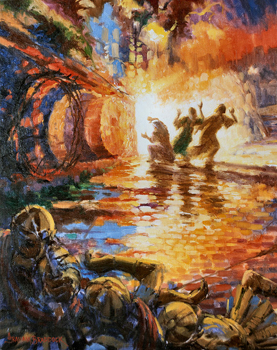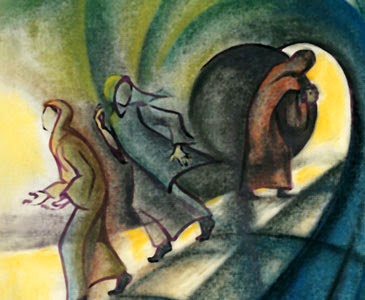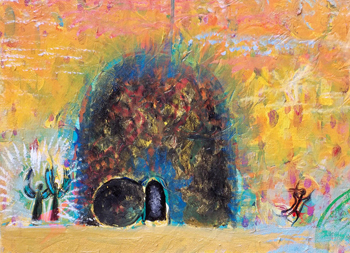For Sunday April 4, 2021
Lectionary Readings (Revised Common Lectionary, Year B)
Isaiah 25:6-9
Psalm 118:1-2,14-24
Acts 10:34-43
Mark 16:1-8 or John 20:1-18
“So they went out and fled from the tomb, for terror and amazement had seized them; and they said nothing to anyone, for they were afraid.”
This is the closing line of Jesus’s resurrection story in Mark's Gospel. I know that Mark’s version isn’t the popular one. Most of us prefer John’s, with its poignant portrayal of Mary Magdalene mistaking Jesus for a gardener, and clinging to him when he speaks her name. John’s version gives us tension and drama: the rash and headstrong Peter running here and there, “the apostle whom Jesus loved” peeking cautiously into an empty tomb, and the risen Jesus himself commissioning Mary to become an “apostle to the apostles,” who shares the staggering news of the resurrection with their scattered friends.
In contrast, Mark’s version is disquieting. We get no glimpses of the risen Jesus. Peter and the other disciples are nowhere to be seen. When a young man in a white robe tells Mary Magdalene and her two companions that Jesus has been raised from the dead, the women don’t cry out in joy; they respond with “alarm,” “terror,” and “amazement.” The angel’s announcement of Good News inspires neither belief nor transformation. We witness no Easter proclamation, no narrative arc from hopelessness to certitude. Instead, we witness fear, flight, and silence.
This week, we celebrate Easter, the high point of our liturgical year. But given the ongoing pandemic, most of us won’t celebrate in the traditional ways we cherish. Some of us won’t gather in person at all. Those of us who can will likely sit masked and socially distanced within our worship spaces, unable to sing, share a common cup around the communion table, or enjoy a festive brunch with friends and extended family after church.
More significantly, when we chant our “Alleluias” and proclaim that “Christ is risen, he is risen indeed!” we’ll do so in the shadow of the 2.7 million beloveds we’ve lost worldwide to Covid-19. In the United States, we will celebrate the empty tomb in the wake of two, still-raw mass shootings; chaos at our southern border; mass unemployment and food insecurity; a deepening crisis of pandemic-induced loneliness, depression, and anxiety; and the ongoing scourge of racial tension, violence, and injustice in our streets and institutions.
 |
As I’ve reflected on the past year during this Lenten season, I’ve been struck again and again by the enormity of what humanity has just endured. We’ve witnessed and/or sustained losses on a scale we’ve barely begun to register, much less to grieve. We’re weary, we’re numb, we’re bewildered, we’re sad. We hear what the angel at the tomb is saying to us, and in some deep recess of our souls we know that the angel’s words are the most consequential words we’ve ever heard. But we’re still trembling in alarm. We’re still trying not to flee.
Maybe, what we need this Easter is Mark’s version of the story. Maybe we need time — as the women in Mark’s account needed time — to sit with the terror and the amazement that must fall upon us when God’s incomprehensible work of redemption collides in real time with the broken bewilderment of our lives. Maybe we don’t need to shout right away. Maybe it’s okay to whisper.
This year, I’m allowing myself to practice a slow Easter — an Easter that takes root within me as imperceptibly as seeds break into life beneath the earth. Anyone who grows green things knows: the process of transformation is hidden from our eyes. Every spring, it is shrouded in mystery. It has a timeline of its own, and we tremble at its seeming fragility. And yet? And yet the tender shoots break through the soil, and new life emerges. Every time.
Likewise, I believe that there is life we cannot see, the life of God hidden within us, tenacious, dynamic, and sure. It might take time to emerge and flourish. But the life itself is certain.
Every Gospel account of the resurrection tells us that the most important event in history happened in total darkness. Sometime in the predawn hours of a Sunday morning two thousand years ago, a great mystery transpired in secret. No sunlight illuminated the event. No human being witnessed it. And even now, centuries later, no human narrative can contain it. The resurrection exceeds all of our attempts to pin it down, because it’s a mystery known only to God. Whatever the raising was and is, its fullness lies in holy darkness, shielded from our eyes. All we can know is that somehow, in an ancient tomb on a starry night, God worked in secret to bring life out of death. Somehow, from the heart of loss and misery, God enacted salvation.
What I respect about Mark’s version of the story is that it honors this mystery. The text doesn’t leap to explanation, to theology, to proof, to joy. It allows the bewilderment of the first witnesses to be exactly what it is. The narrative doesn’t rush.
 |
So often I wish that we, the church, could be so patient, so nuanced, so attuned to spiritual and psychological reality when we speak and share our good news. Wouldn’t our witness be so much more credible if we didn’t feel the need to rush to resurrection? To slap smiles and bows on the wounds of the world? Sometimes, when human beings are in profound pain, good news hurts. We find it too jarring, too dissonant, too grating. We can’t map it, we can’t bridge it, we can’t wrap language around it. We literally can’t take it into our bodies; something tender and essential within us resists. At such moments, maybe the most faithful response to the seeming disconnect between Christ’s resurrection and our continuing pain is a reverent silence. The women at the tomb waited before they spoke; they led with wounded awe, not premature consolation.
I wonder if we shy away from Mark's Gospel because we don't trust the story itself to do its work. We feel some pious need to protect and embellish it. But isn't the really good news this? That the truth of the resurrection doesn’t depend on the religious performance or the spiritual stamina of us flailing human beings? It doesn’t matter one bit if we believe on the spot or not. The tomb is empty. Death is vanquished. Jesus lives. Period. We are not in charge of Easter; God is.
This year in particular, I’m grateful that Scripture preserves the gap between God’s all-sufficient work and our tenuous apprehension of it, because it’s a gap I know so well. I believe (most of the time), but I don’t (yet) understand. I cling to the resurrection, but I don’t know what to do with Death’s ongoing cruelty. I trust that Jesus reigns, but I don’t comprehend the elusive nature of his kingdom. I believe that all things will be well, but I don’t understand why they’re not all well now.
Saint Anselm of Canterbury’s motto for the Christian life was “faith seeking understanding.” I like that. It allows me to accept where I am right now. What have I experienced of Jesus so far? Can I hang onto the faith that is possible in light of my current experience, incomplete though it is? Can I wait in silence as the waves of alarm, fear, amazement, and hope course through me, bringing me slowly, slowly, to resurrection joy?
Often, it’s only in retrospect, only as I look back at the “gravesides” of my life, that I see how God has opened my heart to understanding. Poet R.S. Thomas describes the process this way in his poem, “The Answer:" "There have been times/when, after long on my knees/ in a cold chancel, a stone has rolled/from my mind, and I have looked/in and seen the old questions lie/ folded and in a place/by themselves, like the piled/graveclothes of love’s risen body."
 |
We know from the complete witness of the four Gospels that the frightened silence of the women on Easter morning eventually gave way to proclamation. Their alarm subsided, their courage deepened, their trauma healed, and their amazement grew. They learned how to choose hope. They learned how to make the story their own, and as they did, the story blossomed and grew. Joy came. Faith came. Peace came. Love came. And slowly, the glorious truth of a conquered grave and a risen Messiah made its way from their emboldened lips to every corner of the world. The story didn’t depend on them. But it changed them, and as they changed, the world around them changed, too.
The beautiful thing about taking something slowly is that we can savor it. We need to savor life right now, even as death breathes down our necks, the future feels precarious, and many of our worst fears run wild. So receive the good news of the Resurrection slowly. Hold it, savor it, and ponder it as closely as you can in this moment. You don’t have to force all of its goodness into your wounded heart prematurely; it is trustworthy, and it will wait for you.
But when you can, as you can, hear it again: “Do not be alarmed; you are looking for Jesus of Nazareth, who was crucified. He has been raised; he is not here. Look, there is the place they laid him.”
Can you hear it? All that has been taken so cruelly will be restored. Christ is risen, the grave is empty, love is eternal, and death’s defeat is sure. Nothing will be lost. Whether or not you can bear this great truth right now doesn’t matter. Christ has given it to you. It is yours.
Debie Thomas: debie.thomas1@gmail.com
Image credits: (1) Jason McKnight; (2) Rockwell House Episcopal Campus Ministry; and (3) Fine Art America.





